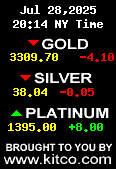Feb 01
The following information was collected compiled by Lemonsock. You can skip past the history and go straight to Mint Marks on Indian Coins if you prefer.
A Brief History of India's Republic Coinage
India won its independence on the 15th of August, 1947. During the period of transition India retained the monetary system and the currency and coinage of the earlier period under British Sovereignty. While Pakistan introduced a new series of coins in 1948 and notes in 1949, India brought out its distinctive coins on August 15, 1950.
Chronologically, the main considerations influencing the coinage policy of the Republic of India over time have been:
1. The incorporation of symbols of sovereignty and indigenous motifs on independence;
2. Coinage Reforms with the introduction of the metric system;
3. The need felt from time to time to obviate the possibility of the metallic value of coins rising beyond the face value;
4. The cost-benefit of switching from currency notes to coins for lower denominations
Republic of India Issues could broadly be categorized as:
The Frozen Series 1947-1950
This represented the currency arrangements during the transition period up to the establishment of the Indian Republic. The Monetary System remained unchanged at One Rupee consisting of 192 pies.
1 Rupee = 16 Annas
1 Anna = 4 Pice
1 Pice = 3 Pies
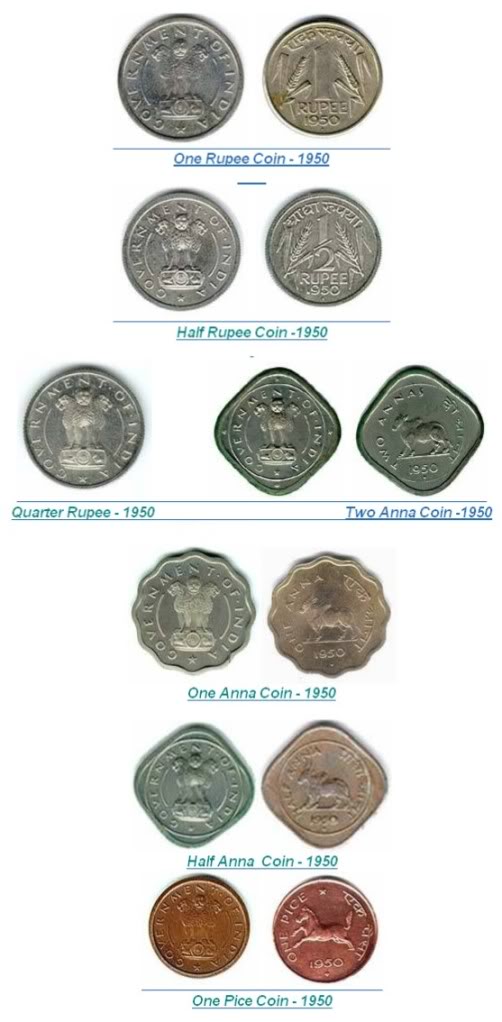
The Anna Series
This series was introduced on the 15th of August, 1950 and represented the first coinage of the Republic of India. The King of England's Portrait was replaced by the Lion Capital of the Ashoka Pillar. A corn sheaf replaced the Tiger on the one Rupee coin. In some ways this symbolized a shift in focus to progress and prosperity. Indian motifs were incorporated on other coins. The monetary system was largely retained unchanged with one Rupee consisting of 16 Annas.
The Decimal Series
The demand for decimalization existed for over a century. Sri Lanka decimalized its rupee in 1869. However, it was in September, 1955 that the Indian Coinage Act was amended for the country to adopt a metric system for coinage. The Act came into force with effective April 1, 1957. The rupee remained unchanged in value and nomenclature. The rupee, however, was now divided into 100 'Paisa' instead of 16 Annas or 64 Pice. For public recognition, the new decimal Paisa was termed 'Naya Paisa' on coins until June 1, 1964 when the term 'Naya' was dropped. Naya being a Hindi word meaning "New." The coins of that period also mentioned their value in terms of the rupee to avoid confusion and deception. For example, the one paisa coin carried the text "One hundredth of a Rupee" in Hindi.
<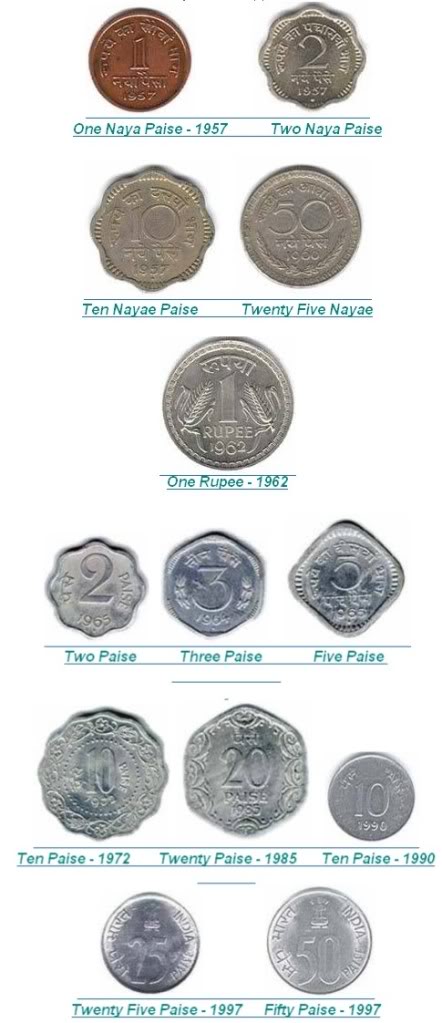
Naya Paisa Series 1957-1964
With commodity prices rising in the sixties, small denomination coins which were made of bronze, nickel-brass, cupro-nickel, and Aluminum-Bronze were gradually minted in Aluminum. This change commenced with the introduction of the new hexagonal 3 paise coin. A twenty paise coin was introduced in 1968 but did not gain much popularity.
Aluminium Series 1964 to Current
In the 1970s the one, two and three paise coins were phased out; Stainless steel coinage of 10, 25 and 50 paise, was introduced in 1988 along with a one rupee coin in 1992. As costs of printing the banknote issues of Re 1, Rs 2, and Rs 5 led to the gradual conversion to coins of these denominations.
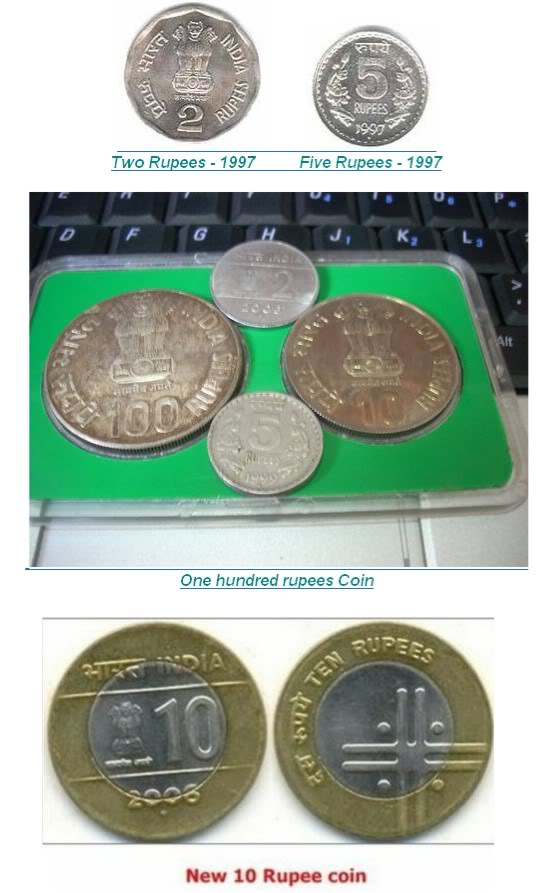
About Commemorative Coins from India
India issues several types of coins. Commemorative coins in various denominations have been issued, including those celebrating Mahatma Gandhi, Jawaharlal Nehru, Indira Gandhi, B. R. Ambedkar, Rajiv Gandhi, Dnyaneshwar, 1982-Asian Games, Sardar Vallabhbhai Patel, Subhash Chandra Bose, Sri Aurobindo, Chittaranjan Das, and Chhatrapati Shivaji.The denominations in circulation currently are 25 and 50 paise and 1, 2 and 5 rupee coins.
Indian Mint Marks on coins
There are four mints in India each with a long & distinguished history that produce coins which serve the nation's everyday needs, The two oldest are Alipore (Calcutta) and Bombay(Mumbai) mints, both were established in 1829 by the British Government, though the former was originally located in Calcutta and moved to its present site in 1952. The Hyderabad mint was established in 1903 by the Government of the erstwhile Nizam of Hyderabad and was taken over by the Government of India in 1950, which began minting Republic coinage in 1953. The Noida mint was set up in 1986 and started minting ferritic stainless steel coins from 1988.
1. MUMBAI MINT : The Bombay Mint has a small dot or diamond mint mark under Date of the Coin.
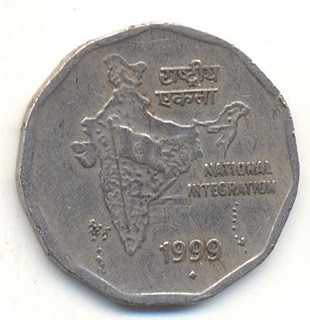
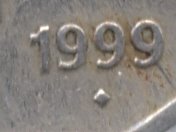
2. CALCUTTA MINT : The Calcutta Mint has No Mint Mark beneath the date of coin.


3. HYDERABAD MINT : The Hyderabad Mint has a five-point star under the date of coin.

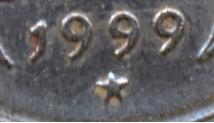
4. NOIDA MINT : The Noida Mint has a small or thick dot under the date of the Coin.

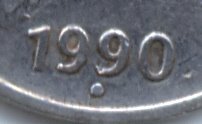
Foreign Mint Marks on Indian Coins
The government of India issued many coins minted by foreign mints during times of shortage of coins. Some coins were minted abroad and imported in 1857-58, 1943, 1985, 1997-2002 and these bear the mint marks of their origin. These coins are imported with the approval of Reserve Bank of India. All the coins minted in foreign mints are shown below:
(a) SEOUL MINT(SOUTH KOREA)-The Seoul mint has a five-point star under the date of the coin but it is exactly below the first or Last Digits of dates 1985 and 1997..
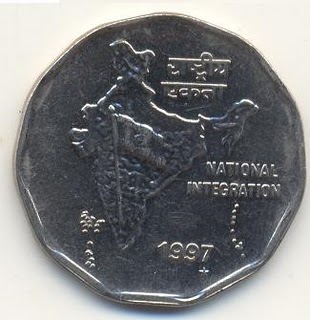

(b) ROYAL MINT LLANTRISANT, SOUTH WALES -The Birmingham Mint has a small dot under the date of the coin but it is exactly below the First Digit of Date 1985.

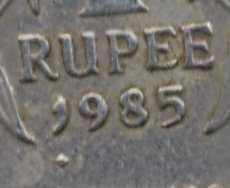
(c) HEATON PRESS MINT(U.K)-This Mint has Ornamental/ Decorated Letter "H" under the last digit of the date 1985.

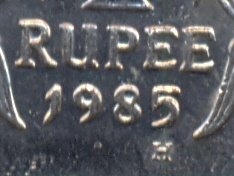
(d) ROYAL CANADIAN MINT, WINNIPEG-This Ottawa Mint has a "C" mint mark under the date of the coin.
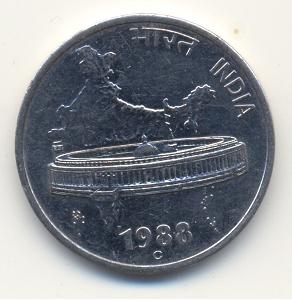
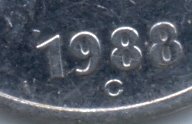
(e) MEXICO MINT(OESCHGER MASDACH & Co.)-The Mexico City Mint has an mint mark of "M beneath O under " under the date of the coin.
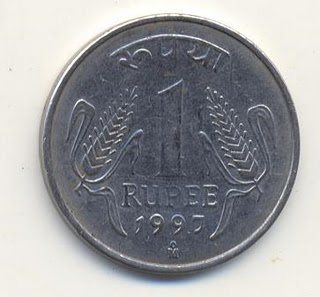 <
<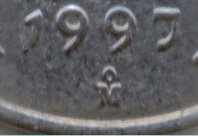
(f) MOSCOW MINT – This mint has a mint mark of MMD in oval below the date of the coin.eg 2 rupee & 5 rupee(2000 A.D)

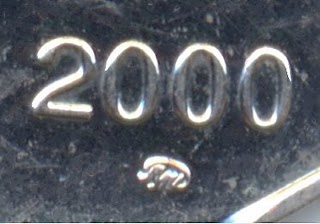
(g) KREMNCA MINT (SLOVAKIA REPUBLIC): Has mint mark of MK in circle below the date of the coin on rupee 1998-2000.

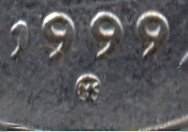
(h) PRETORIA MINT(SOUTH AFRICA MINT Co. pvt ltd) : has "M" under date in 1998 two rupee coin.

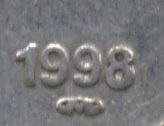
(i) DOMINICAN REPUBLIC

A Brief History of India's Republic Coinage
India won its independence on the 15th of August, 1947. During the period of transition India retained the monetary system and the currency and coinage of the earlier period under British Sovereignty. While Pakistan introduced a new series of coins in 1948 and notes in 1949, India brought out its distinctive coins on August 15, 1950.
Chronologically, the main considerations influencing the coinage policy of the Republic of India over time have been:
1. The incorporation of symbols of sovereignty and indigenous motifs on independence;
2. Coinage Reforms with the introduction of the metric system;
3. The need felt from time to time to obviate the possibility of the metallic value of coins rising beyond the face value;
4. The cost-benefit of switching from currency notes to coins for lower denominations
Republic of India Issues could broadly be categorized as:
The Frozen Series 1947-1950
This represented the currency arrangements during the transition period up to the establishment of the Indian Republic. The Monetary System remained unchanged at One Rupee consisting of 192 pies.
1 Rupee = 16 Annas
1 Anna = 4 Pice
1 Pice = 3 Pies

The Anna Series
This series was introduced on the 15th of August, 1950 and represented the first coinage of the Republic of India. The King of England's Portrait was replaced by the Lion Capital of the Ashoka Pillar. A corn sheaf replaced the Tiger on the one Rupee coin. In some ways this symbolized a shift in focus to progress and prosperity. Indian motifs were incorporated on other coins. The monetary system was largely retained unchanged with one Rupee consisting of 16 Annas.
The Decimal Series
The demand for decimalization existed for over a century. Sri Lanka decimalized its rupee in 1869. However, it was in September, 1955 that the Indian Coinage Act was amended for the country to adopt a metric system for coinage. The Act came into force with effective April 1, 1957. The rupee remained unchanged in value and nomenclature. The rupee, however, was now divided into 100 'Paisa' instead of 16 Annas or 64 Pice. For public recognition, the new decimal Paisa was termed 'Naya Paisa' on coins until June 1, 1964 when the term 'Naya' was dropped. Naya being a Hindi word meaning "New." The coins of that period also mentioned their value in terms of the rupee to avoid confusion and deception. For example, the one paisa coin carried the text "One hundredth of a Rupee" in Hindi.
<

Naya Paisa Series 1957-1964
With commodity prices rising in the sixties, small denomination coins which were made of bronze, nickel-brass, cupro-nickel, and Aluminum-Bronze were gradually minted in Aluminum. This change commenced with the introduction of the new hexagonal 3 paise coin. A twenty paise coin was introduced in 1968 but did not gain much popularity.
Aluminium Series 1964 to Current
In the 1970s the one, two and three paise coins were phased out; Stainless steel coinage of 10, 25 and 50 paise, was introduced in 1988 along with a one rupee coin in 1992. As costs of printing the banknote issues of Re 1, Rs 2, and Rs 5 led to the gradual conversion to coins of these denominations.

About Commemorative Coins from India
India issues several types of coins. Commemorative coins in various denominations have been issued, including those celebrating Mahatma Gandhi, Jawaharlal Nehru, Indira Gandhi, B. R. Ambedkar, Rajiv Gandhi, Dnyaneshwar, 1982-Asian Games, Sardar Vallabhbhai Patel, Subhash Chandra Bose, Sri Aurobindo, Chittaranjan Das, and Chhatrapati Shivaji.The denominations in circulation currently are 25 and 50 paise and 1, 2 and 5 rupee coins.
Indian Mint Marks on coins
There are four mints in India each with a long & distinguished history that produce coins which serve the nation's everyday needs, The two oldest are Alipore (Calcutta) and Bombay(Mumbai) mints, both were established in 1829 by the British Government, though the former was originally located in Calcutta and moved to its present site in 1952. The Hyderabad mint was established in 1903 by the Government of the erstwhile Nizam of Hyderabad and was taken over by the Government of India in 1950, which began minting Republic coinage in 1953. The Noida mint was set up in 1986 and started minting ferritic stainless steel coins from 1988.
1. MUMBAI MINT : The Bombay Mint has a small dot or diamond mint mark under Date of the Coin.

2. CALCUTTA MINT : The Calcutta Mint has No Mint Mark beneath the date of coin.


3. HYDERABAD MINT : The Hyderabad Mint has a five-point star under the date of coin.


4. NOIDA MINT : The Noida Mint has a small or thick dot under the date of the Coin.

Foreign Mint Marks on Indian Coins
The government of India issued many coins minted by foreign mints during times of shortage of coins. Some coins were minted abroad and imported in 1857-58, 1943, 1985, 1997-2002 and these bear the mint marks of their origin. These coins are imported with the approval of Reserve Bank of India. All the coins minted in foreign mints are shown below:
(a) SEOUL MINT(SOUTH KOREA)-The Seoul mint has a five-point star under the date of the coin but it is exactly below the first or Last Digits of dates 1985 and 1997..

(b) ROYAL MINT LLANTRISANT, SOUTH WALES -The Birmingham Mint has a small dot under the date of the coin but it is exactly below the First Digit of Date 1985.

(c) HEATON PRESS MINT(U.K)-This Mint has Ornamental/ Decorated Letter "H" under the last digit of the date 1985.

(d) ROYAL CANADIAN MINT, WINNIPEG-This Ottawa Mint has a "C" mint mark under the date of the coin.

(e) MEXICO MINT(OESCHGER MASDACH & Co.)-The Mexico City Mint has an mint mark of "M beneath O under " under the date of the coin.

(f) MOSCOW MINT – This mint has a mint mark of MMD in oval below the date of the coin.eg 2 rupee & 5 rupee(2000 A.D)

(g) KREMNCA MINT (SLOVAKIA REPUBLIC): Has mint mark of MK in circle below the date of the coin on rupee 1998-2000.

(h) PRETORIA MINT(SOUTH AFRICA MINT Co. pvt ltd) : has "M" under date in 1998 two rupee coin.

(i) DOMINICAN REPUBLIC
